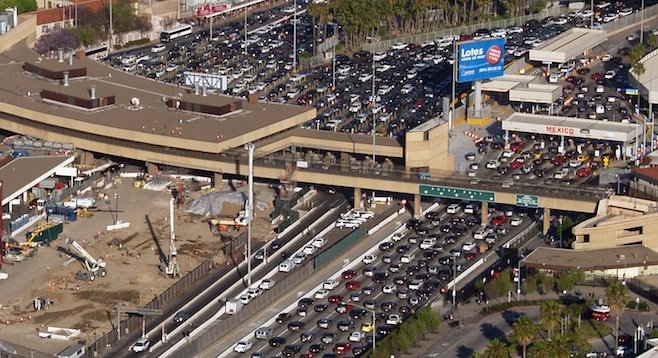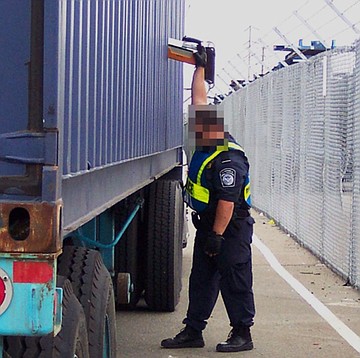 Facebook
Facebook
 X
X
 Instagram
Instagram
 TikTok
TikTok
 Youtube
Youtube

How safe from nuclear smugglers is San Diego's border with Mexico?

Not enough, according to the U.S. Government Accountability Office, which has released a censored version of a report to Congress. The document, entitled "Combating Nuclear Smuggling," says more details about the success or failure of the government's "covert efforts" need to be compiled.
In the meantime, the results of covert anti-nuclear smuggling activities at the frontier here and other U.S. border crossings are being withheld from the public.
"This report is a public version of the prior sensitive report that we provided to you," says a letter, dated September 22, 2014, to Michael T. McCaul, chairman of the House Homeland Security committee from the Government Accountability Office.
According to the letter, Homeland Security "determined that some of the information in the prior report was Sensitive Security Information and For Official Use Only and must be protected from public disclosure.
"Therefore, this report omits sensitive information about [Customs and Border Protection] covert operations, including the results of covert operations as well as DHS’s radiological and nuclear detection capabilities at U.S. air, land, and sea ports of entry and checkpoints."
What can be told isn't pretty.
"A terrorist’s use of either an improvised nuclear device or a radiological dispersal device — could have devastating consequences, including not only loss of life but also enormous psychological and economic impacts," the report says.
"An [improvised nuclear device] is a crude nuclear bomb made with highly enriched uranium or plutonium, generally referred to as special nuclear materials.
“It would create an explosion producing extreme heat, powerful shockwaves, and intense radiation that would be immediately lethal to individuals within miles of the explosion, as well as radioactive fallout over thousands of square miles.”
According to the document, the government employs "covert action" to track whether or not customs and law enforcement officials are adequately prepared to catch would-be nuclear smugglers.
"An actor attempts to smuggle a hidden radiological or nuclear source material through a port of entry or checkpoint by hiding the source material in a vehicle, cargo, or luggage and attempting to enter the country with it," says the report.
"The operation is recorded using a variety of surveillance equipment."
"[Customs and Border Protection] officials observe the test and take notes….
"After the covert test is complete, [Operational Field Testing Division] officials interview the [Customs] officers or U.S. Border Patrol agents involved in the operation and discuss test results with them, explaining what went well and what areas are in need of improvement."
But due to "resource constraints," the audit says, reports regarding the success or failure of the activities "have not been timely and do not include the results of covert tests conducted at checkpoints….
"Further, developing a mechanism to track whether ports of entry and checkpoints have implemented corrective actions could help inform management decision making on the need for further investments in equipment or personnel training to protect U.S. borders."
The document gives no details of what else the investigators may have discovered and provides only rudimentary information regarding the number of covert checks made.
"About half of these covert operations were conducted at the Southwest border, primarily in the state of Texas,” the document says. "For example, between 2008 and 2013, CBP conducted 4 operations at Houston’s sea ports of entry."
According to a table attached to the report, California ports of entry conducted 19 covert operations between Fiscal Years 2006 through 2013, ranking the state second to Texas, which had 37.
In a September 12 letter, Homeland Security officials acknowledged the problem and promised to do better, including making a bureaucratic switch.
"With the pending transfer of the program from the Office of Internal Affairs to the Office of Intelligence and Investigative Liaison, [Customs and Border Protection] is optimistic that this move will have a positive effect on the program and that OIIL's intelligence assets will produce a synergistic effect in CBP's ability to detect and interdict nuclear and radiological materials and thereby strengthen border security."


How safe from nuclear smugglers is San Diego's border with Mexico?

Not enough, according to the U.S. Government Accountability Office, which has released a censored version of a report to Congress. The document, entitled "Combating Nuclear Smuggling," says more details about the success or failure of the government's "covert efforts" need to be compiled.
In the meantime, the results of covert anti-nuclear smuggling activities at the frontier here and other U.S. border crossings are being withheld from the public.
"This report is a public version of the prior sensitive report that we provided to you," says a letter, dated September 22, 2014, to Michael T. McCaul, chairman of the House Homeland Security committee from the Government Accountability Office.
According to the letter, Homeland Security "determined that some of the information in the prior report was Sensitive Security Information and For Official Use Only and must be protected from public disclosure.
"Therefore, this report omits sensitive information about [Customs and Border Protection] covert operations, including the results of covert operations as well as DHS’s radiological and nuclear detection capabilities at U.S. air, land, and sea ports of entry and checkpoints."
What can be told isn't pretty.
"A terrorist’s use of either an improvised nuclear device or a radiological dispersal device — could have devastating consequences, including not only loss of life but also enormous psychological and economic impacts," the report says.
"An [improvised nuclear device] is a crude nuclear bomb made with highly enriched uranium or plutonium, generally referred to as special nuclear materials.
“It would create an explosion producing extreme heat, powerful shockwaves, and intense radiation that would be immediately lethal to individuals within miles of the explosion, as well as radioactive fallout over thousands of square miles.”
According to the document, the government employs "covert action" to track whether or not customs and law enforcement officials are adequately prepared to catch would-be nuclear smugglers.
"An actor attempts to smuggle a hidden radiological or nuclear source material through a port of entry or checkpoint by hiding the source material in a vehicle, cargo, or luggage and attempting to enter the country with it," says the report.
"The operation is recorded using a variety of surveillance equipment."
"[Customs and Border Protection] officials observe the test and take notes….
"After the covert test is complete, [Operational Field Testing Division] officials interview the [Customs] officers or U.S. Border Patrol agents involved in the operation and discuss test results with them, explaining what went well and what areas are in need of improvement."
But due to "resource constraints," the audit says, reports regarding the success or failure of the activities "have not been timely and do not include the results of covert tests conducted at checkpoints….
"Further, developing a mechanism to track whether ports of entry and checkpoints have implemented corrective actions could help inform management decision making on the need for further investments in equipment or personnel training to protect U.S. borders."
The document gives no details of what else the investigators may have discovered and provides only rudimentary information regarding the number of covert checks made.
"About half of these covert operations were conducted at the Southwest border, primarily in the state of Texas,” the document says. "For example, between 2008 and 2013, CBP conducted 4 operations at Houston’s sea ports of entry."
According to a table attached to the report, California ports of entry conducted 19 covert operations between Fiscal Years 2006 through 2013, ranking the state second to Texas, which had 37.
In a September 12 letter, Homeland Security officials acknowledged the problem and promised to do better, including making a bureaucratic switch.
"With the pending transfer of the program from the Office of Internal Affairs to the Office of Intelligence and Investigative Liaison, [Customs and Border Protection] is optimistic that this move will have a positive effect on the program and that OIIL's intelligence assets will produce a synergistic effect in CBP's ability to detect and interdict nuclear and radiological materials and thereby strengthen border security."
Comments